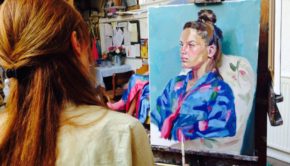Learning English through Art
Learning English as a Foreign Language (and teaching English as a Foreign Language) is becoming big business these days, as English becomes more accepted as a global lingua franca and an integral part of international communication. More and more people are realising they need to learn English to survive and succeed in the academic and business worlds and so are signing up for English lessons. Most of these take place in a classroom or a boardroom but there is no reason why this should be the case.
Why not take learning outside the classroom and into the real world?
There are many opportunities for learning that don’t require four walls, tables and chairs. Instead, language can be learnt through practical applications. Though this is sometimes done by teachers taking their students out of the classroom and on excursions, this is often done as a way to take a break from teaching and not as a way of learning. However, excursions provide perfect learning opportunities and there is a place for this to be the norm for learning rather than the exception.
Learning English through Art is one such example.
Teachers can recreate their English lessons as Art lessons. Students have lessons in art (in a studio if possible, or just the classroom) and through experimentation with colour, materials and techniques they will learn to communicate in English. By undertaking instruction only in English not only will their listening skills improve dramatically but so too will their vocabulary range increase and their knowledge of grammar advance. In turn, students will be focussing on communication rather than the accurate reproduction of language and as they become successful, they will feel more comfortable dealing with language and more confident speaking the language.
Students do not need to be fluent in English to take these lessons and students in the same class do not necessarily need to be the same level. Classes are more organic and less structured so there is no level system as there is in a school. Students also do not need to be experienced artists as the art they create is personal and the teacher will provide help on an individual basis.
Teaches may feel ill-equipped to handle such lessons if they have no background in art, but they need not feel anxious. Teachers do not need to be trained artists because they can do research beforehand or find resources online which will inform their lessons. Bear in mind, these are not university-level Art classes; you will be dealing with concepts in art which you are likely to be familiar with. Plus, it will be your students doing the practical work!
On the other hand, if it’s not viable to provide art lessons for students, then you may need to contact a local art school and try to organise with them. Art schools usually offer a range of classes from drawing and photography to painting and sculpture and they sometimes have workshops or lectures. In this way they are able to cater for students who wish to attend a one- or two-day workshop or a single lecture and those who would like to study on a more regular basis. As such, it is easy for an English learner to find something that suits them.
If there is no time in your schedule to experiment with art in the classroom, using a local art school can provide your learners with a way to practice their English on an extra-curricular basis. We are always urging our learners to engage with the language in the real world and providing them with a concrete opportunity to do so may just be the encouragement they need.
- From Classroom to Clubhouse: My Journey Teaching English at a Portuguese Golf Club - August 25, 2024
- The Impacts of Teaching in Africa - December 5, 2022
- Job Searching In The Digital Age: A Guide - September 3, 2022
- Why Golf is one of the Best Ways to Learn English - June 15, 2022
- How to travel smart with medical conditions - April 24, 2022
- 5 Ways TEFL Teachers can Develop New Skills - December 14, 2021
- How to Calculate the Cost of a Postgraduate Degree - April 11, 2021
- Building a career as a TEFL teacher - December 29, 2016
- Learning English through Art - August 31, 2016
- Does Art Have A Place In The Language Learning Classroom? - August 31, 2016
















